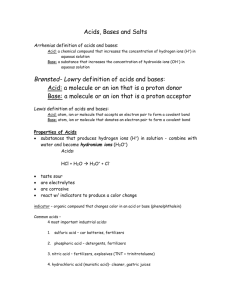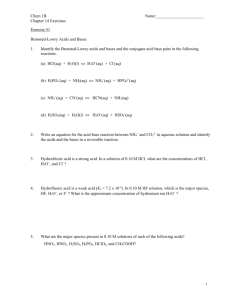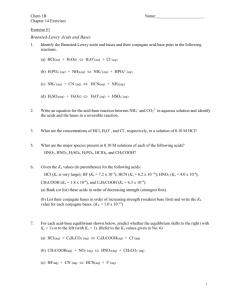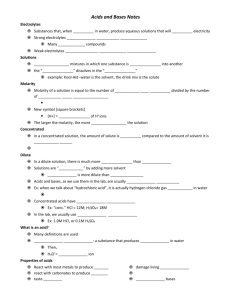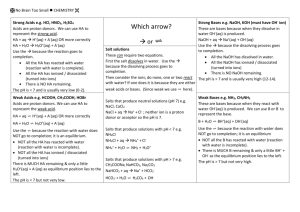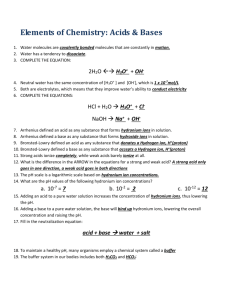acids and bases - No Brain Too Small
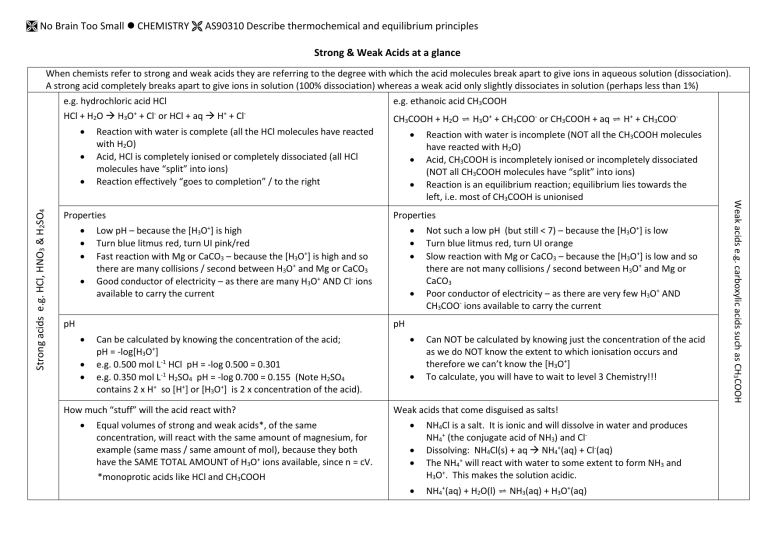
No Brain Too Small
CHEMISTRY
AS90310 Describe thermochemical and equilibrium principles
Strong & Weak Acids at a glance
When chemists refer to strong and weak acids they are referring to the degree with which the acid molecules break apart to give ions in aqueous solution (dissociation).
A strong acid completely breaks apart to give ions in solution (100% dissociation) whereas a weak acid only slightly dissociates in solution (perhaps less than 1%) e.g. hydrochloric acid HCl
HCl + H
2
O H
3
O + + Cl or HCl + aq H + + Cl -
Reaction with water is complete (all the HCl molecules have reacted with H
2
O)
Acid, HCl is completely ionised or completely dissociated (all HCl molecules have “split” into ions)
Reaction effectively “goes to completion” / to the right e.g. ethanoic acid CH
3
COOH
CH
3
COOH + H
2
O
⇌
H
3
O + + CH
3
COO or CH
3
COOH + aq
⇌
H + + CH
3
COO -
Reaction with water is incomplete (NOT all the CH
3
COOH molecules have reacted with H
2
O)
Acid, CH
3
COOH is incompletely ionised or incompletely dissociated
(NOT all CH
3
COOH molecules have “split” into ions)
Reaction is an equilibrium reaction; equilibrium lies towards the left, i.e. most of CH
3
COOH is unionised
Properties
Low pH – because the [H
3
O + ] is high
Turn blue litmus red, turn UI pink/red
Fast reaction with Mg or CaCO
3
– because the [H
3
O + ] is high and so there are many collisions / second between H
3
O + and Mg or CaCO
3
Good conductor of electricity – as there are many H
3
O + AND Cl ions available to carry the current pH
Can be calculated by knowing the concentration of the acid; pH = -log[H
3
O + ]
e.g. 0.500 mol L -1 HCl pH = -log 0.500 = 0.301
e.g. 0.350 mol L -1 H
2
SO
4
pH = -log 0.700 = 0.155 (Note H
2
SO
4 contains 2 x H + so [H + ] or [H
3
O + ] is 2 x concentration of the acid).
How much “stuff” will the acid react with?
Equal volumes of strong and weak acids*, of the same concentration, will react with the same amount of magnesium, for example (same mass / same amount of mol), because they both have the SAME TOTAL AMOUNT of H
3
O + ions available, since n = cV.
*monoprotic acids like HCl and CH
3
COOH
Properties
Not such a low pH (but still < 7) – because the [H
3
Turn blue litmus red, turn UI orange
Slow reaction with Mg or CaCO
3
– because the [H
3
O +
O +
] is low
] is low and so there are not many collisions / second between H
3
O + and Mg or
CaCO
3
Poor conductor of electricity – as there are very few H
3
O + AND
CH
3
COO ions available to carry the current pH
Can NOT be calculated by knowing just the concentration of the acid as we do NOT know the extent to which ionisation occurs and therefore we can’t know the [H
3
O + ]
To calculate, you will have to wait to level 3 Chemistry!!!
Weak acids that come disguised as salts!
NH
4
Cl is a salt. It is ionic and will dissolve in water and produces
NH
4
+ (the conjugate acid of NH
3
) and Cl -
Dissolving: NH
4
Cl(s) + aq NH
4
+ (aq) + Cl (aq)
The NH
4
+ will react with water to some extent to form NH
3
and
H
3
O + . This makes the solution acidic.
NH
4
+ (aq) + H
2
O(l)
⇌
NH
3
(aq) + H
3
O + (aq)
No Brain Too Small
CHEMISTRY
AS90310 Describe thermochemical and equilibrium principles
Strong & Weak Bases at a glance
When chemists refer to strong and weak bases they are referring to the degree with which the bases (ionic compounds or molecules) break apart to give ions in aqueous solution (dissociation). A strong base completely breaks apart to give ions in solution whereas a weak base only slightly dissociates in solution.
e.g. sodium hydroxide, NaOH (an ionic solid)
NaOH + aq Na + + OH *
Reaction with water is complete
The NaOH is completely ionised or completely dissociated (the
NaOH ionic lattice has “split” into ions)
Reaction effectively “goes to completion” / to the right
* Don’t write NaOH + H
2
O … or you will end up with problems or end up writing H
2
O on both sides of the arrow!
e.g. ammonia, NH
3
NH
3
+ H
2
O
⇌
NH
4
+ + OH -
Reaction with water is incomplete (NOT all the NH
3
molecules have reacted with H
2
O)
The base NH
3
is incompletely ionised or incompletely dissociated
(NOT all NH
3
molecules have “split” into ions)
Reaction is an equilibrium reaction; equilibrium lies towards the left, i.e. most of NH
3
is unionised
Properties
High pH – because the [OH ] is high
Turn red litmus blue, turn UI purple
Good conductor of electricity – as there are many ions available to carry the current pH
Can be calculated by knowing the concentration of the base; o Find [H
3
O + ]; [H
3
O + ] = 1 x 10 -14 / [OH ] o Then find the pH; pH = -log[H
3
O + ]
e.g. 0.800 mol L -1 NaOH o [OH o [H
3
O
] = 0.800 mol L
+ ] = 1 x 10
-1 ;
-14 / 0.800 = 1.25 x 10 -14 mol L -1 o pH = - log 1.25 x 10 -14 and so pH = 13.9
NOTE:
There are usually less questions comparing strong and weak bases as the bases don’t have such visible reactions with other substances. e.g. when base + acid salt + water there is no visible sign of reaction, no bubbles of any gas etc, so it is hard to compare any “rate of reaction”.
Properties
Not such a high pH (but still > 7) – because the [OH
Turn red litmus blue, turn UI dark green-blue
] is low
Poor conductor of electricity – as there are very few ions available to carry the current pH
Can NOT be calculated by knowing just the concentration of the base as we do NOT know the extent to which ionisation occurs and therefore we can’t know the [OH ]
To calculate, you will have to wait to level 3 Chemistry!!!
Weak bases that come disguised as salts!
NaHCO
3
is a salt. It is ionic and will dissolve in water and produces
Na + and HCO
3
-
Dissolving: NaHCO
The HCO
3
-
3
(s) + aq Na + (aq) + HCO
3
OH . This makes the solution alkaline/basic.
(aq)
will react with water to some extent to form H
2
CO
3
and
HCO
3
- (aq) + H
2
O(l)
⇌
H
2
CO
3
(aq) + OH (aq)


